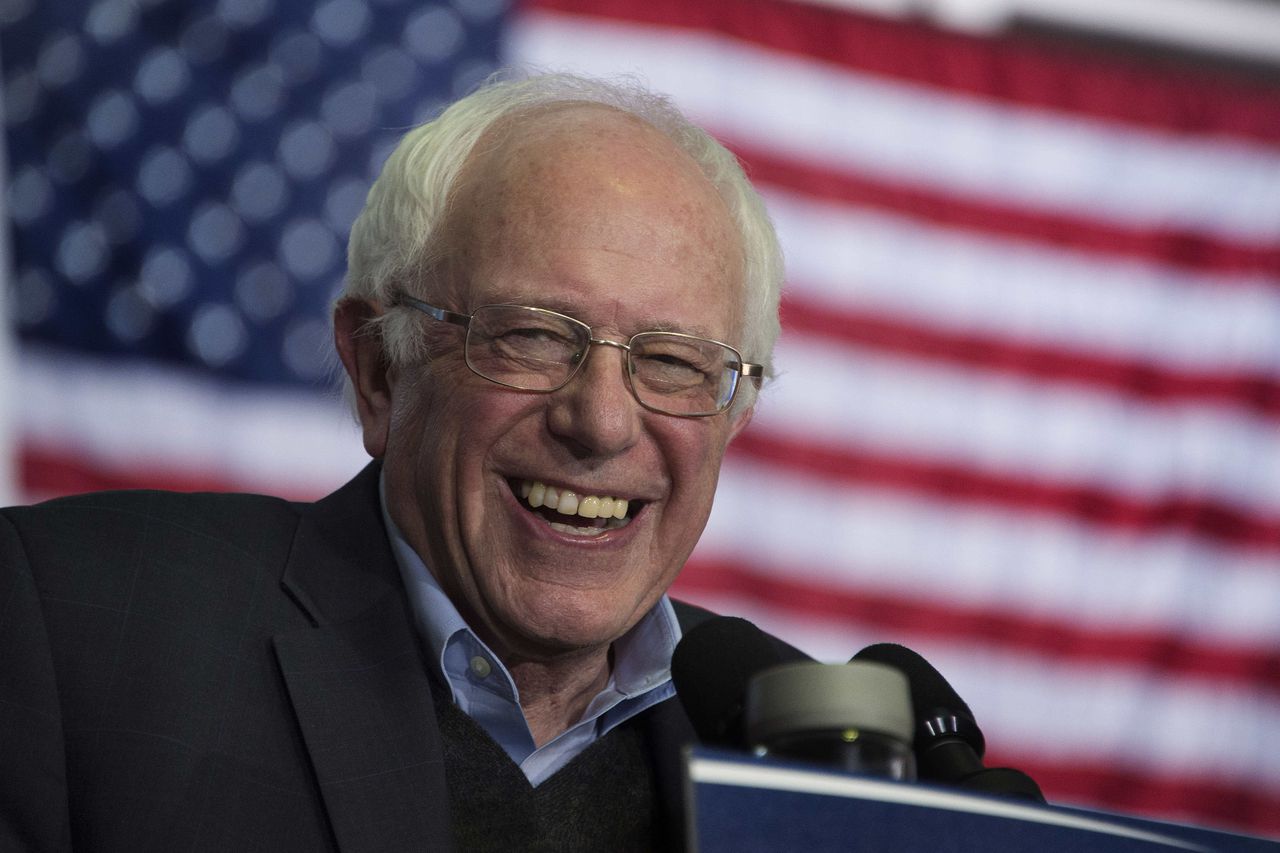Yes, Bernie Sanders could still win the Democratic nomination.
Make no mistake, Hillary Clinton is clearly winning now. She has 768 pledged delegates compared with Sanders's 553, according to Vox's delegate tracker. She's locked up most of the "superdelegates."And there are no big winner-take-all states in the Democratic primary to buoy Sanders at the 11th hour. If current trends continue, Clinton will win with room to spare.
But though a Sanders comeback looks unlikely, Sanders's whole candidacy has been unlikely. Indeed, just this Tuesday, the Vermont senator shocked the punditry yet again with an upset victory in Michigan, a state where polls showed him down by more than 20 points.
Now, if Sanders hopes to catch up to Clinton, he'll need not just several more upsets like Michigan, but several more upsets bigger than Michigan. It's a tall order — he'll likely need to beat Clinton in most of the biggest states remaining, win landslides in heavily white states, and improve his performance among black and Hispanic voters substantially. But it's not impossible to imagine.
So here's my best attempt at gaming out how a path to victory for Sanders would actually look, as per the delegate math. There won't be any sugarcoating here — this scenario would require the race to shift in Sanders's favor. But elections can take surprising turns. If the following five things happen, Sanders could actually pull this off.1) Sanders needs to win at least 54 percent of the remaining pledged delegates
First off, the primaries and caucuses in the Democratic nomination process are all about amassing pledged delegates. You win them proportionally in each state. (We'll get to superdelegates later.)- Sanders currently has 553 or so pledged delegates.
- He needs 2,026 for the barest possible majority of the 4,051 pledged delegates.
- There are 2,736 pledged delegates still to be allocated.
- So Sanders needs 1,473 of those 2,736, or 54 percent, to get there.
That's because, unlike on the Republican side, there are no big winner-take-all states lurking later in the calendar that could swing a whole batch of delegates to Sanders's side at once. Instead, every Democratic contest allocates delegates proportionally — meaning the only way to rack up a lot more pledged delegates than your rival is by winning big victories.
For an initial crude estimate to put us in the ballpark for what Sanders would need, his average result in the upcoming contests would have to be somewhere in the ballpark of an 8-point victory over Clinton (54-46). And of course, these upcoming states are of different sizes, so those Sanders wins can't just be concentrated in small states.2) Sanders has to come out ahead in the six biggest states left
As of today, 29 states, four territories, and the District of Columbia still haven't voted in the Democratic contest.But let's put things in perspective here — more than half of all the remaining delegates are in just six states: California, New York, Florida, Pennsylvania, Illinois, and Ohio.
Given his existing delegate deficit, Sanders simply cannot afford to get blown out in these six states. Indeed, he needs to come out ahead in them. For instance, if he ends up splitting the delegates from these six states with Clinton evenly, he'd then need to win 58 percent of the delegates in all the other contests for that pledged delegate majority (which, again, means his average outcome across all those varied states and territories would have to be a 58-42 win — and that's completely implausible).Unfortunately for Sanders, Clinton's home state of New York is one of these "big six." So if Clinton wins handily there, Sanders would have to do quite well in the other five to cancel that out.
- Three of them — Illinois, Ohio, and Pennsylvania — are Rust Belt states where Sanders would have to outright win rather than just essentially tie, as he did in Michigan.
- The other two — California and Florida — have large Hispanic populations. And of the two Hispanic-heavy states to have voted so far, Nevada and Texas, Sanders narrowly lost one and didn't even come close in the other.
And he doesn't have the luxury of time, either — three of these states (Illinois, Ohio, and Florida) are voting on Tuesday, March 15. If the polls are right, Sanders is on track to lose big in Florida, so keep an eye on whether he can make up for that with stronger-than-expected performances in Ohio and Illinois.
3) Sanders needs landslides in the whitest states
Sanders has done extremely well in states with large white populations so far. So any path that leads to him passing Clinton would likely involve doing even better in those states going forward.Yet the heavily white states that have already voted have been either from Sanders's home region of New England (Maine, New Hampshire, Vermont) or Midwestern caucus states (Kansas, Nebraska, Minnesota).
The remaining big, heavily white states are mainly either Midwestern primary states (Ohio, Indiana, Wisconsin), Western states (Oregon, Utah, Idaho), or Appalachian states (Kentucky, West Virginia).It's not yet clear whether Sanders can win these states by margins similar to those he pulled in New England and in the Midwestern caucuses. But if he wants to close the gap with Clinton he essentially has to do so, since Clinton won such enormous landslides of 30 points or more in so many Southern states, and Sanders has to cancel those out somehow.
4) Sanders needs to (at least) fight Clinton to a draw overall in less white states
Even after Sanders came out ahead of Clinton in the Big Six and won the remaining heavily white states in landslides, he'd still need more.That's because there's still another batch of 600 or so delegates in states and territories with large nonwhite populations. These include:- North Carolina and Maryland, which have similar demographic breakdowns to several of the Southern states Clinton won so big in
- New Jersey, which is next door to Clinton's home state of New York
- Arizona and New Mexico, which have big Hispanic populations
- Puerto Rico, which Clinton won in a blowout in 2008
5) The superdelegates have to be flexible
If Sanders pulls all the above off and improbably gets a pledged delegate majority, he'd then face a new problem: the superdelegates.Currently, Clinton is netting more than 400 superdelegates more than Sanders. If that advantage holds, Sanders would need to do far, far better than the already ambitious targets laid out above. Indeed, he'd need to win 70 percent of the remaining pledged delegates in order to catch up. That's an all but impossible feat in the Democrats' proportional system — it means that in the remaining states, Sanders's average result would have to be a 40-point victory over Clinton. Not happening.
So to construct any plausible Sanders path to victory, we basically have to assume that many of the superdelegates who have endorsed Clinton will eventually be willing to change their minds if Sanders beats her in pledged delegates.That's not a crazy assumption — Democratic superdelegates have never dethroned the leader in pledged delegates. And if Sanders passes Clinton in that count, there will surely be immense public pressure on superdelegates to carry out the "will of the people," rather than swing the nomination toward an insider. (That's why we've excluded superdelegates from Vox's delegate tracker — because they can change their minds.)
However, Sanders is such a party outsider, and there is such concern about how he'd do in a general election, that superdelegates might well try to swing the race toward Clinton after all. We just don't know yet.
A scenario for a Sanders victory
So, to recap, here's what I see as the most plausible — though still implausible — Sanders victory scenario.- Sanders wins, say, 53 percent of the delegates in those Big Six states, likely through big wins in the Rust Belt states of Illinois, Ohio, and Pennsylvania, and through improving his performance with Hispanic voters in California.
- He racks up landslide after landslide in the other states remaining that are 70 percent white or more, and comes away with about 62 percent of those delegates.
- And he then fights Clinton to a draw in the remaining contests where nonwhite voters are more heavily represented, picking up 48 percent of those delegates.
- This would give Sanders — just barely — a majority in pledged delegates. But it wouldn't give him the nomination. For that, he'd then need enough of the superdelegates to swing to his side or remain neutral.
src


























